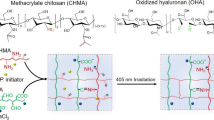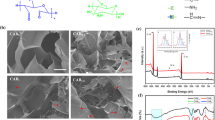Abstract
Regenerative medicine proposes to regenerate or even replace human damaged tissues to return to normal functions. Hence, biomaterials have been used to provide appropriate environment for cell development. Among the groups of biodegradable biomaterials, hydrogels, which are characterized by three-dimensional and cross-linked networks of water-soluble polymers, have been highlighted as suitable matrices for such applications. An injectable hydrogel based on oxidized galactomannan (OxGM) from Delonix regia and N-succinyl chitosan (NSC) was developed and characterized according to its physicochemical and biocompatible properties. The hydrogel was formed by Schiff base (−CH = N−) cross-linking between aldehyde groups from OxGM and NH2 groups from NSC, in few minutes (9.7 min) without any external stimulus. A hydrogel with macroporous structure, interconnected pores, and porosity of 69% was obtained. The biomaterial exhibited excellent injectability. No change in volume or integrity was observed in the hydrogel after its swelling in phosphate buffered saline (PBS) medium. This is an important property because when the hydrogel is injected into the site of interest and it fills the environment, it will not have additional space to occupy. Biocompatibility studies were conducted in vitro, which revealed the non-cytotoxic nature of the material and demonstrated the potential of the hydrogel based on dialdehyde galactomannan and N-succinyl chitosan for cell culture and soft tissue engineering.







Similar content being viewed by others
References
Chen FM, Liu X. Advancing biomaterials of human origin for tissue engineering. Prog Polym Sci. 2016;53:86–68. https://doi.org/10.1016/j.progpolymsci.2015.02.004
Patenaude M, Smeets NMB, Hoare T. Designing injectable, covalently cross-linked hydrogels for biomedical applications. Macromol Rapid Commun. 2014;35:598–617. https://doi.org/10.1002/marc.201300818
Slaughter BV, Khurshid SS, Fisher OZ, Khademhosseini A, Peppas NA. Hydrogels in regenerative medicine. Adv Mater. 2009;21:3307–29. https://doi.org/10.1002/adma.200802106
Li Y, Rodrigues J, Tomás H. Injectable and biodegradable hydrogels: gelation, biodegradation and biomedical applications. Chem Soc Rev. 2012;41:2193–221. https://doi.org/10.1039/C1CS15203C
Thambi T, Phan VHG, Lee DS. Stimuli-sensitive injectable hydrogels based on polysaccharides and their biomedical applications. Macromol Rapid Commun. 2016;37:1881–96. https://doi.org/10.1002/marc.201600371
Sinha VR, Kumria R. Polysaccharides in colon-specific drug delivery. Int J Pharm. 2001;224:19–38. https://doi.org/10.1016/S0378-5173(01)00720-7
Thombare N, Jha U, Mishra S, Siddiqui MZ. Guar gum as a promising starting material for diverse applications: a review. Int J Biol Macromol. 2016;88:361–72. https://doi.org/10.1016/j.ijbiomac.2016.04.001
Wang X, Gu Z, Qin H, Li L, Yang X, Yu X. Crosslinking effect of dialdehyde starch (DAS) on decellularized porcine aortas for tissue engineering. Int J Biol Macromol. 2015;79:813–21. https://doi.org/10.1016/j.ijbiomac.2015.05.044
Jia Y, Li J. Molecular assembly of schiff base interactions: construction and application. Chem Rev. 2015;115:1597–621. https://doi.org/10.1021/cr400559g
Patenaude M, Hoare T. Injectable, mixed natural-synthetic polymer hydrogels with modular properties. Biomacromolecules. 2012;13:369–78. https://doi.org/10.1021/bm2013982
Wei Z, Yang JH, Liu ZQ, Xu F, Zhou JX, Zrínyi M, Osada Y, Chen YM. Novel biocompatible polysaccharide-based self-healing hydrogel. Adv Funct Mater. 2015;25:1352–9. https://doi.org/10.1002/adfm.201401502
Raftery RM, Woods B, Marques ALP, Moreira-Silva J, Silva TH, Cryan SA, Reis RL, O’Brien FJ. Multifunctional biomaterials from the sea: assessing the effects of chitosan incorporation into collagen scaffolds on mechanical and biological functionality. Acta Biomater. 2016;43:160–9. https://doi.org/10.1016/j.actbio.2016.07.009
Qu J, Zhao X, Ma PX, Guo B. pH-responsive self-healing injectable hydrogel based on N-carboxyethyl chitosan for hepatocellular carcinoma therapy. Acta Biomater. 2017;58:168–80. https://doi.org/10.1016/j.actbio.2017.06.001
Ren Y, Zhao X, Liang X, Ma PX, Guo B. Injectable hydrogel based on quaternized chitosan, gelatin and dopamine as localized drug delivery system to treat Parkinson’s disease. Int J Biol Macromol. 2017;105:1079–87. https://doi.org/10.1016/j.ijbiomac.2017.07.130
Bashir S, Teo YY, Ramesh S, Ramesh K. Physico-chemical characterization of pH-sensitive N-Succinyl chitosan-g-poly (acrylamide-co-acrylic acid) hydrogels and in vitro drug release studies. Polym Degrad Stab. 2017;139:38–54. https://doi.org/10.1016/j.polymdegradstab.2017.03.014
Kamoun EA. N-succinyl chitosan-dialdehyde starch hybrid hydrogels for biomedical applications. J Adv Res. 2016;7:69–77. https://doi.org/10.1016/j.jare.2015.02.002
Rogalsky AD, Kwon HJ, Lee-Sullivan P. Compressive stress-strain response of covalently crosslinked oxidized-alginate/N-succinyl-chitosan hydrogels. J Biomed Mater Res. 2011;99 A:367–75. https://doi.org/10.1002/jbm.a.33192
Tan H, Chu CR, Payne KA, Marra KG. Injectable in situ forming biodegradable chitosan-hyaluronic acid based hydrogels for cartilage tissue engineering. Biomaterials. 2009;30:2499–506. https://doi.org/10.1016/j.biomaterials.2008.12.080
Yan S, Wang T, Feng L, Zhu J, Zhang K, Chen X, Cui L, Yin J. Injectable in situ self-cross-linking hydrogels based on poly(l -glutamic acid) and alginate for cartilage tissue engineering. Biomacromolecules. 2014;15:4495–508. https://doi.org/10.1021/bm501313t
Zhao H, Heindel ND. Determination of degree of substitution of formul groups in polyaldehyde dextran by the hydroxylamine hydrochloride method. Pharm Res. 1991;8:400–2. https://doi.org/10.1023/A:1015866104055
Sarker B, Li W, Zheng K, Detsch R, Boccaccini AR. Designing porous bone tissue engineering scaffolds with enhanced mechanical properties from composite hydrogels composed of modified alginate, gelatin, and bioactive glass. ACS Biomater Sci Eng. 2016;2:2240–54. https://doi.org/10.1021/acsbiomaterials.6b00470
Karageorgiou V, Kaplan D. Porosity of 3D biomaterial scaffolds and osteogenesis. Biomaterials. 2005;26:5474–91. https://doi.org/10.1016/j.biomaterials.2005.02.002
Liu M, Zheng H, Chen J, Li S, Huang J, Zhou C. Chitosan-chitin nanocrystal composite scaffolds for tissue engineering. Carbohydr Polym. 2016;152:832–40. https://doi.org/10.1016/j.carbpol.2016.07.042
Ou X, Zheng J, Zhao X, Liu M. Chemically Cross-Linked Chitin Nanocrystal Scaffolds for drug delivery. ACS Appl Nano Mater. 2018;12:6790–9. https://doi.org/10.1021/acsanm.8b01585
Lin WC, Lien CC, Yeh HJ, Yu CM, Hsu SH. Bacterial cellulose and bacterial cellulose-chitosan membranes for wound dressing applications. Carbohydr Polym. 2013;94:603–11. https://doi.org/10.1016/j.carbpol.2013.01.076
Bružauskaite I, Bironaite D, Bagdonas E, Bernotiene E. Scaffolds and cells for tissue regeneration: different scaffold pore sizes—different cell effects. Cytotechnology. 2016;68:355–69. https://doi.org/10.1007/s10616-015-9895-4
Zhang L, Ge H, Xu M, Cao J, Dai Y. Physicochemical properties, antioxidant and antibacterial activities of dialdehyde microcrystalline cellulose. Cellulose. 2017;24:2287–98. https://doi.org/10.1007/s10570-017-1255-4
Amer H, Nypelö T, Sulaeva I, Bacher M, Henniges U, Potthast A, Rosenau T. Synthesis and characterization of periodate-oxidized polysaccharides: dialdehyde xylan (DAX). Biomacromolecules. 2016;17:2972–80. https://doi.org/10.1021/acs.biomac.6b00777
Lin ZT, Song K, Bin JP, Liao YL, Jiang GB. Characterization of polymer micelles with hemocompatibility based on N-succinyl-chitosan grafting with long chain hydrophobic groups and loading aspirin. J Mater Chem. 2011;21:19153–65. https://doi.org/10.1039/C1JM13208C
Fathi A, Mithieux SM, Wei H, Chrzanowski W, Valtchev P, Weiss AS, Dehghani F. Elastin based cell-laden injectable hydrogels with tunable gelation, mechanical and biodegradation properties. Biomaterials. 2014;35:5425–35. https://doi.org/10.1016/j.biomaterials.2014.03.026
Naseri N, Poirier JM, Girandon L, Fröhlich M, Oksman K, Mathew AP. 3-Dimensional porous nanocomposite scaffolds based on cellulose nanofibers for cartilage tissue engineering: Tailoring of porosity and mechanical performance. RSC Adv. 2016;6:5999–6007. https://doi.org/10.1039/C5RA27246G
Annabi N, Nichol JW, Zhong X, Ji C, Koshy S, Khademhosseini A, Dehghani F. Controlling the porosity and microarchitecture of hydrogels for tissue engineering. Tissue Eng. 2010;16:371–83. https://doi.org/10.1089/ten.teb.2009.0639
Saporito F, Baugh LM, Rossi S, Bonferoni MC, Perotti C, Sandri G, Black L, Ferrari F. In situ gelling scaffolds loaded with platelet growth factors to improve cardiomyocyte survival after ischemia. ACS Biomater Sci Eng. 2019;5:329–38. https://doi.org/10.1021/acsbiomaterials.8b01064
Xu H, Zhang L, Cai J. Injectable, self-healing, β-chitin-based hydrogels with excellent cytocompatibility, antibacterial activity, and potential as drug/cell carriers. ACS Appl Bio Mater. 2019;2:196–204. https://doi.org/10.1021/acsabm.8b00548
Barnes JM, Przybyla L, Weaver VM. Tissue mechanics regulate brain development, homeostasis and disease. J Cell Sci. 2017;130:71–82. https://doi.org/10.1242/jcs.191742
Acknowledgements
The authors wish to acknowledge the National Council of Scientific and Technological Development (CNPq, Brazil), the Coordination for the Improvement of Higher Education Personnel (CAPES, Brazil), INOMAT/INCT (Brazil), and FUNCAP (Brazil) for financial support in the form of grants and fellowships. The authors are grateful to Analytical Center from Federal University of Ceará (UFC) for the SEM analysis and Centro Nordestino de Aplicação e Uso da Ressonância Magnética Nuclear (CENAUREMN) for the NMR analysis.
Author information
Authors and Affiliations
Corresponding author
Ethics declarations
Conflict of interest
The authors declare that they have no conflict of interest.
Additional information
Publisher’s note Springer Nature remains neutral with regard to jurisdictional claims in published maps and institutional affiliations.
Rights and permissions
About this article
Cite this article
Lucas de Lima, E., Fittipaldi Vasconcelos, N., da Silva Maciel, J. et al. Injectable hydrogel based on dialdehyde galactomannan and N-succinyl chitosan: a suitable platform for cell culture. J Mater Sci: Mater Med 31, 5 (2020). https://doi.org/10.1007/s10856-019-6343-6
Received:
Accepted:
Published:
DOI: https://doi.org/10.1007/s10856-019-6343-6




